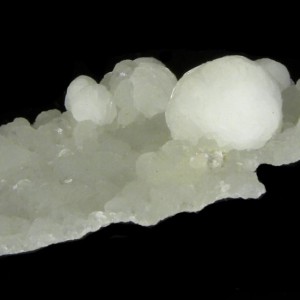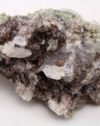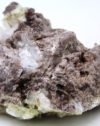HISTORY, NAME, LOCALITIES: Gyrolite, pronounced JYE-row-lite, was recognized as a mineral species in 1851 after study of specimens from its type locality on the Isle of Skye, Scotland. Its name stems from the Greek gyros, meaning “circle” and alluding to its typical occurrence in spherical masses. It is collected in Australia, Canada, China, the Czech Republic, Denmark, France, Germany, Greenland, Iceland, India, Italy, Japan, Norway, Russia, the United Kingdom, and the United States (Arizona, California, New Jersey, Idaho, Oregon, Virginia, Wyoming).
MINERALOGY, PROPERTIES, OCCURRENCE: Gyrolite [basic hydrous sodium calcium oxysilicate, (NaCa2)Ca14(Si23Al)O60(OH)8•(14+x)H2O] crystallizes in the triclinic system, often in pseudohexagonal form and usually as radiating, spherical masses. It is transparent to translucent, often fluorescent, and has a Mohs hardness of 2.5, specific gravity of 2.45-2.51, vitreous luster, and colors that range from white and colorless to brown. It occurs almost exclusively in vugs in basalt or basaltic tuff, often in association with zeolite minerals. Despite its close association with zeolite minerals, it is not a member of the zeolite group.
METAPHYSICAL PROPERTIES, LORE, USES: As an uncommon mineral, gyrolite has no technological or gemstone uses. Metaphysical practitioners believe that gyrolite cleanses, activates, and increases the healing powers of other crystals. It also enhances sensuality, sexuality, and intimacy; facilitates meditation; brings insight into ancient civilizations; and helps to overcome addictive behavior and excessive introversion.
COLLECTORS’ INFORMATION: Gyrolite is collected in composite specimens in association with apophyllite-KF, prehnite, and various zeolite minerals.





 Axinite #10
Axinite #10  Axinite #8
Axinite #8